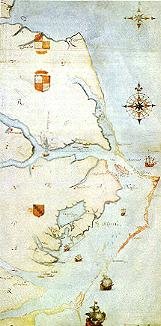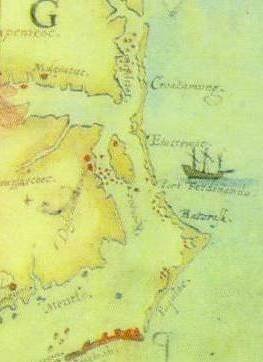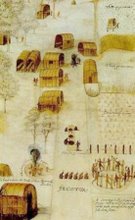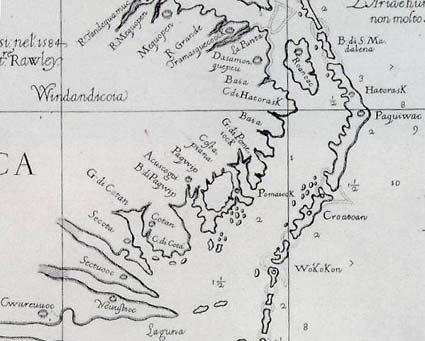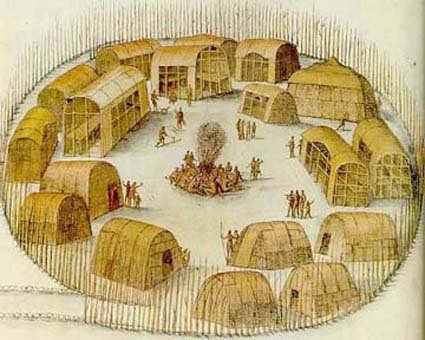Jennifer Sheppard, Genealogist for the Lost Colony Research Group, presented a program to the Martin County Historical Society at their meeting on September 23rd in Williamston, NC. Jennifer described how the Lost Colony Research Group is using Genealogy and DNA testing to prove the oral histories that there are living descendants of the Lost Colony living in north eastern North Carolina today. DNA kits were on hand for testing and she assisted one person, Chris Smith, shown in the photo, with collecting his DNA following the presentation. Brenda Monty, another attendee and a reporter for the local newspaper, the Enterprise, photographed Chris taking the DNA test.
Wednesday, September 29, 2010
Jennifer Sheppard, LCRG Genealogist, presents program to Martin County Historical Society
Jennifer Sheppard, Genealogist for the Lost Colony Research Group, presented a program to the Martin County Historical Society at their meeting on September 23rd in Williamston, NC. Jennifer described how the Lost Colony Research Group is using Genealogy and DNA testing to prove the oral histories that there are living descendants of the Lost Colony living in north eastern North Carolina today. DNA kits were on hand for testing and she assisted one person, Chris Smith, shown in the photo, with collecting his DNA following the presentation. Brenda Monty, another attendee and a reporter for the local newspaper, the Enterprise, photographed Chris taking the DNA test.
Posted by
Historical Melungeons
at
9/29/2010 01:59:00 PM
![]()
Labels: lost colony, Lost Colony DNA
Wednesday, September 22, 2010
1580's Snaphaunce Gunlock Found on Hatteras
During my own research, I have sought other experts to help me understand the significance of certain finds, namely a gunlock that may date to the late 16th century (which would be highly significant!) and the Kendall ring (an artifact that may relate to one member of the Roanoke voyages, can be viewed here: http://digital.lib.ecu.edu/special/ead/view.aspx?id=1061&q=croatan ). These items were found by the late Dr. David S. Phelps, Professor Emeritus at East Carolina University. An ECU report on this archaeological site is available at http:///www.delabrooke.com/ECUreportGray.pdf. I have made the resources available to all for the sake of unbiased opinions.
This gunlock was examined previously by Dr. James D. Lavin of William & Mary University in Virginia. Unfortunately, I’ve not been able to locate the professor, who is retired and we know nothing about what he found. He may have had previous experience with research groups that turned him off to the Lost Colony project. That would be unfortunate. However, Dr. Lawrence Babits, director of the Maritime History program at ECU told me to contact Bly Straube of Jamestown Rediscovery who happens to be a published expert on snaphaunce mechanisms, which this piece is believed to be. My first email to her included this photo that you see above without mention of where it came from (I did not want to bias any opinions that she might give). Her immediate response was that it looked like “1580s snaphaunce” and she sounded mightily excited about it.
This blog is © History Chasers
Click here to view all recent Lost Colony Research Group Blog posts
Posted by
Historical Melungeons
at
9/22/2010 11:16:00 PM
![]()
Labels: Gunlock, hatteras, Snaphaunce
Tuesday, September 21, 2010
Lost Colony Research Group featured on WRAL -TV
If you can't view the video CLICK HERE
This blog is © History Chasers
Click here to view all recent Lost Colony Research Group Blog posts
Posted by
Historical Melungeons
at
9/21/2010 08:31:00 AM
![]()
Wednesday, September 15, 2010
Lost Colony Featured in Special TV Segment
We're pleased to announce that the Lost Colony Research Group and DNA project are being featured on WRAL-TV out of Raleigh/Durham this coming Monday, September 20th at 5:55 PM. Scott Mason interviewed our own Dawn Taylor and Scott Dawson of the Croatoan Archaeological Society a few weeks ago for this segment. For those not in the viewing area, it will be posted on their website at www.wral.com later the same night.
Our thanks to Scott Mason and WRAL.
This blog is © History Chasers
Click here to view all recent Lost Colony Research Group Blog posts
Posted by
Historical Melungeons
at
9/15/2010 09:33:00 PM
![]()
Saturday, September 11, 2010
Using a Blog for Genealogy Record Keeping
From the Dear Myrtle Blog:
Using a blog for research note-taking
"A blog can certainly be used to plan a research project and to document progress. The added benefit when traveling to research facilities is that these blogged research notes can be accessed through any computer with internet access. "
http://blog.dearmyrtle.com/2010/09/using-blog-for-research-note-taking.html
by Janet Crain
There are some very good points here. For one, blogs such as Blogger are so configurable that you can store records for years. You can keep records in draft or make your blog in whole or part private. And you can access these records anywhere you have Internet access.
I am experimenting now with using blogger to host the LEWIS Surname DNA Project website. It can be updated on the fly and used to host static pages of info as well. The Internet is evolving. Genealogy presentation and record keeping will also.
There are expensive programs to do this with. But Blogger is FREE. And no ads. Check it out.
This blog is © History Chasers
Click here to view all recent Lost Colony Research Group Blog posts
Posted by
Historical Melungeons
at
9/11/2010 11:18:00 PM
![]()
Thursday, September 2, 2010
Hatteras Island Hurricane, Roberta Estes
1936 Hatteras Island Hurricane
In the next few days, I'll be writing a book review for an absolutely lovely book titled Confessions of an Outer Banks Filly by Sybil Skakle who was raised on Hatteras Island. She brings the island of her childhood in the 1930s to life for us. However, today, with the impending hurricane, Earl, about to descend on Hatteras Island, I want to share with you Sybil's description of the 1936 hurricane on Hatteras. For those who have never experienced such, well, you're fortunate. Those who lived there on that remote island with no roads or bridges were in essence trapped. You fared better to open your doors and let the angry sea roar through your home on the ribbon of land in the Atlantic called Hatteras.....but let's let Sybil tell the story in this excerpt from her book...
The one in 1933 - before hurricanes had names- frightened me most. It had no parallel in my memory. In more recent years there have been more devastating ones to Hatteras Island. However, It is that one I remember best.
Wind was gusting up to 100 mph, taking railing and chimney off the Weather Bureau, which we could see from the Pamlico side of our house, across Aunt Martha Oden's yard. It had blown out the window in the upstairs hall, at the top of our stairs and water rose to the third stair step in our house before it began to recede.
Frightened by the advancing tide, recalling the story of Noah's Ark (but not the promise of the rainbow) I buried my face in the ruff of our small, white dog Dobby's neck and cried and prayed that God would save us. When I came down stairs, the tide had lowered on the steps. My prayer had been answered.
Able-bodied men had volunteered or been recruited to raise the piano and our kerosene-run refrigerator with wooden bottle crates from Daddy's store. They had been raised to the ceiling, bottle crate by bottle crate. Other furniture that could be transported up those inside stairs had been moved to the upper floor. But up there, every pot and pan or chamber pot that could be found was situated beneath a leak from the cedar-shingled roof, which did not leak with ordinary showers. Wind whistled under the eves and around the windows, which rattled in their casings. The house swayed in the wind.
We had seen the hurricane light signals the night before. Now the two square red flags with black square centers flapped furiously in the wind.
*********************
Following is an account by my mother, Inez Daniels Austin from Hatteras, dated September 17, 1936:
All day the storm has threatened. Radio reports warn us to move out of the storm area. Lots they know how slim our chances of making a single move to save our lives. The only thing we can do is open our homes to the strangers within our storm-closed gates.
The people who live nearer the shore may move in nearer the center of the beach land to homes that are no safer perhaps than those right along the sound or ocean front. One little pitiful mile is the width at the widest point that separates us at this very moment from a very uncertain end.
There is one thing more we can do. We can keep on praying that a Heavenly Father will help us to be sane and sensible at this time and help us to be brave. He calmed the storm on the wind-tossed Galilee. He can do the same today.
Or are we so sinful that we must be shown the power through the elements of a Father's mighty hand?
We hope with every passing moment that the intensity of the storm may lower. We have been given by last report a slim hope that the storm may veer out to sea. Perhaps the land will not get it quite so intensely as we now fear.
May the hand that rules us all wave a gentle wand over the troubled waters and still their tempestuous tossing.
How relieved each heart - how grateful- should the wind quietly lower and no damage come to us and our poor earthly possessions.
The last reports says 11:30 is the time set for the most dangerous hour of the storm at this point. We wait with bated breath, hoping against hope that we may not get it so terribly bad here. The tide is over the land, still rising higher and higher.
The Coast Guardsman reports by phone that he is being rocked to sleep in the tower as he watches. They have seen so many storms, so they seem unafraid. (The phone was in Austin's Store.)
At 12:30 the water is now 14 inches deep in the down stairs rooms.
We have the piano 24 inches off the floor, also a davenport on two chairs (wooden). (Sewing) machine is on the desk; refrigerator on boxes, Victrola and upholstered chairs on the tables.
The wind is still very strong and flurries seem to indicate that it is increasing in velocity.
Mr. Poe (Rev. John Poe) has gone to bed, also, Shanklin. Decatur (cousin) and Josephine look like ostriches on their nest, lying on couch about halfway up to the side of the wall. Mr. (Marion) Holland (Hatteras school teacher) in another corner on davenport, on a high perch. Andrew sits on a high chair on first stair step, feet propped on second step. I am sitting on a stool, water sloshing up under same.
***************************
We had eaten breakfast with our feet in the tide beneath the dining table; had watched the wind drive the tide across the top of the cistern beyond the windows. The demands of the storm had kept us all busy through the day. Later, when the tides had receded, Jo, an older sister, had been among the brave and curious who went to observe the damage and take pictures.
The Northern Methodist Church building and many homes had been washed off their foundations, helped by the wind. Our father's freight boat Cathleen had been driven aground and left high and dry near scaffolds where nets were hung to dry. Trees had been uprooted and blown down. Fences were blown over or floated away. Vegetation was destroyed. Caskets and the Hatteras School cistern, which must have been empty, floated out of the ground.
To reduce the likelihood of our house floating, we opened the doors for the tide. As the tide began to recede, every available broom had someone sweeping the silt out with the tide. Water contamination was one of the worst threats to our health. Water in the cisterns, no longer fit to drink, could only be used to clean the remaining mud and grime from the floors. Everything, wet from the tide or the rain, needed time to dry. It took weeks to be rid of the smell of mud and mold.
And so it was in 1936 and has been before and since on Hatteras Island. Today we pray for our island friends as Earl approaches and know that they are better prepared than the colonists or Indians were in the past to survive a major assault from Mother Nature.
You can purchase Sybil's book, Confessions of an Outer Banks Filly at Manteo Booksellers in Manteo, NC or at http://www.amazon.com/Confessions-Outer-Banks-Austin-Skakle/dp/1880849372/ref=sr_1_1?ie=UTF8&s=books&qid=1283456992&sr=8-1
This blog is © History Chasers
Click here to view all recent Lost Colony Research Group Blog posts
Posted by
Historical Melungeons
at
9/02/2010 05:49:00 PM
![]()
Labels: Hatteras Island Hurricane
Sunday, August 22, 2010
Virginia Dare or The Birth of a Nation, Baylus Brooks
Born 18th August 1587
A tiny mewling baby all red and splotchy
And already fiercely independent.
What joy filled their hearts as her cries
Drifted on the scented air.
So many hopes and fears swaddled tight,
One small bundle with the future of a nation
Grasped briefly in her chubby pink fingers.
What became of Virginia Dare
And the others of the "Lost Colony"?
How long did they search
With no trace ever found.
Only the grey eyed Indians
Perhaps held the key.
How long did she live?
Such an heroic name for little Virginia Dare
One name remembered amongst a multitude
Of others long forgotten.
Today, we set fair for Roanoke… to the beginnings of the story that holds a nation spellbound in wonder. For us, the “great mystery” only requires evidence to prove that it was no mystery. And our efforts over the many years (months for myself) have gained great riches! But, Anne and Dawn (and eventually me) came to Manteo today to promote our endeavors, yes, but mostly to honor the birthday of Virginia Dare, daughter of Ananias and Eleanor Dare, first English child to be born in what is now the United States. It occurred on Roanoke Island right here in North Carolina.
The festivities at the Lost Colony Theater grounds were to begin at 11:00 a.m. Where was I? Touring the island of Roanoke. For me, it was my first visit. Arriving at 8:30 a.m. I had plenty of opportunity to visit the Roanoke Festival Park first and tour the Elizabethan-era remake of a type of English ship that brought our colonists from England to these shores. The facilities that made this ship are located on the island as well.
I stayed long enough to watch a harquebus being fired from the deck of the ship. This was a deck-mounted affair (as opposed to shoulder-mounted) that was quickly reloadable through the use of a removable powder canister that could be refilled and reloaded in short order. The smoke and roar was not bad compared to its bigger brothers and sisters usually kept below on the gun deck.

I also had a chance to stop in at the Outer Banks History Center, a part of the North Carolina Division of Archives and History. There are several good Hatteras collections that will require our close attention. Sarah, a curator at the center, gave me some excellent research tips on Hatteras history and previous work.
I also stopped by the Settlement Re-enactment to speak with the blacksmith, who worked in an old wattle and daub type structure very similar to what the colonists would have used. While I was there, I drilled him on what modifications he thought that the colonists might have made to their structures after having moved off the island, possibly incorporating Algonquian building techniques as did the Jamestown colonists after realization that the wetter weather made that necessary. They covered their homes in tree bark to make them more weatherproof.
From the Festival Park, I arrived just after 11 to find Anne and Dawn hard at work. They were already set up with various potsherds of both Indian and English manufacture, all found mixed at the same level on Hatteras Island, near Buxton. There were also deer bone that Anne will tell you proves that there was plenty of food to support the mere 100+ colonists of 1587.
Our intrepid archaeologists also found a half-naked Algonquian man to “talk” to. Yeah, right! I did notice that there were no half-naked Algonquian females around. Hmmmph! Good girl, Dawn, keeping your hands carefully crossed in front of you like that.
Well, I’m not a half-naked Indian, but somehow I managed to get between the gals. This was a great opportunity for me because I have never met these two great researchers. We have spent the summer communicating by email and I have hundreds of emails to prove it. A lot of progress has been made too. I’m looking forward to the digs in November and April to find what we have spent the past few months theorizing and maybe learn from my partners a little about archaeological work and methods.

After packing up for the day, Anne and Dawn decided to give me a tour backstage of the Lost Colony Theater. Here’s what it looks like when no one is around. But, there are more goodies in the back…
They decided to make a brief stop to vandalize a local tree before moving on, however.
The crew was preparing for that night’s performance as we arrived and we toured the grounds. Luckily, they knew these guys and we didn’t get thrown out!
We even got into the costume department and even the makeup. Of course, we didn’t get to be in the play but you can’t have everything. I even have a really good 16th-century English accent… at least the guys at the Settlement said so. They were well-practiced with theirs.
here be ye props… I’ve been looking for a chair just like that for my living room, too.
Well, it’s been a great trip but, I had to be off to get ready for school. My wife and I both start this week. So, these two will watch tonight’s play and then sit around in their hotel room and, as Bobbi wistfully recalled, speculate on what happened with those abandoned colonists that we now know so well:
I remember my first time at that cast party sitting looking over the water and watching a shooting star. What must they have thought when they saw them too? Did they think they were omens that they were going to be rescued, or relieved, or maybe just visited by people from England with news of their families? Did they see John White's boats in the 1590 trip sail by Croatoan Island and was that smoke a desperate signal? Did they follow the ships to Roanoke as quickly as they could, only to discover they were too late? Did they know how close they were to rescue or replenishment?
Goodnight, Virginia Dare! We’ll get together again next year. Maybe by then, we’ll have some news of your grandfather, John White. Maybe we’ll even know you a little better as well. Whatever we find, I’m sure we’ll have fun doing it! As for ye rest, Fare thee well, ye lubbers!
Baylus Brooks
This blog is © History Chasers
Click here to view all recent Lost Colony Research Group Blog posts
Posted by
Historical Melungeons
at
8/22/2010 03:21:00 PM
![]()
Labels: Baylus Brooks, virginia dare
Wednesday, August 18, 2010
Virginia Dare Birthday Celebration August 18th
Waterside Theatre Presenting These Entertaining Productions in 2010!
Virginia Dare Faire
This blog is © History Chasers
Click here to view all recent Lost Colony Research Group Blog posts
Posted by
Historical Melungeons
at
8/18/2010 11:04:00 AM
![]()
Labels: birthday, Lost Colony Roanoke, virginia dare
Tuesday, August 17, 2010
Virginia Dare Faire: Happy Birthday Virginia!!!

Tomorrow is the big day!!!
Virginia Dare Faire
Celebrate Virginia Dare’s 423rd birthday at Fort Raleigh National Historic Site on Roanoke Island. Attend a full day of free activities for the family that include make and take crafts; games; entertainment; activities; free cake and ice cream. Reserve your seats early for the evening performance of The Lost Colony that cameos infant actors as baby Virginia—ticket charges apply.
We are very fortunate to have two representatives, Anne Poole and Dawn Taylor, who will be staffing a DNA testing booth. We expect to have photos soon.
This blog is © History Chasers
Click here to view all recent Lost Colony Research Group Blog posts
Posted by
Historical Melungeons
at
8/17/2010 10:40:00 PM
![]()
Labels: Lost Colony of Roanoke, virginia dare
Sunday, August 15, 2010
Memories, author Jeri Evans
The story of the Lost Colony has become part of the fabric of my family history. Oral history passed along from previous generations tells the story of the colonists, celebrates the birth of Virginia Dare and hints at a possible link between their fate and our beginnings. Our family has been celebrating their lives through story-telling prior to the beginning of the outdoor drama and by embracing the live performance once it became a reality.
Home base for my family is Washington County, NC, on the south shore of the Albemarle Sound, approximately 50 miles west of the Outer Banks. As a child growing up in the 1950’s, I traveled with my family on many trips to the Outer Banks and Roanoke Island. Our typical excursion was just for the day but at least once a year there was an over-night stay in order to see the Lost Colony drama.
Our family was large and we generally attended the Lost Colony as a group. I loved the play and was always eager to attend the performance. At that time, the entrance to the historic site was flanked by two large wooden towers placed there to create the impression of entering an actual fort. Riding through the entrance towers was very impressive to a small child with a large imagination. There were also log houses and a church on the site that were built based on an assumption of what the colonists may have created. All towers and other structures have long since been removed as they were not original to the site.
We would time our arrival at Fort Raleigh in the late afternoon. We’d purchase tickets upon arrival and set up our picnic area to enjoy a homemade dinner before the play began. There was usually time available for my cousins and I to visit the theatre before dinner. The stage and sets were open and we would play on the set acting out our version of the drama and taking turns pretending to be the main characters. The youngest cousins were always Virginia Dare by default because they could fit into the cradle. Members of the cast would occasionally stop and visit with us as we played.
At dusk we would proceed into the theatre and that’s when, for me, the magic began. The pathway to the theatre led through the oaks which had been shaped by coastal winds, twisted and bent at odd angles with long low branches that crossed over our heads. Lighting was provided at ground level but on both sides and above us it was dark. The entrance into the theatre was a replica of a wooden fort with double gates cut into the center of the structure. Once in the theatre, we always made our way to the right to seats in the middle of the right side section. The seating consisted of rows of benches with no backs and no cushions. The play began with haunting organ music that echoed across the theatre and a choir began singing a hymn. The narrator appeared to the left, illuminated by a spotlight and began the story of Raleigh’s colony. The organ music lingers in my memory, the sound gave me chills as a child and I confess I miss that sound when I attend the performance today. I was fascinated by the Indians and no matter how many times I’d seen the play, I was always startled when the Indians jumped out from the side stages and ran through the audience with their weapons, shouting their war cries. I laughed at the antics of Old Tom and Agona and wished Ananias Dare had been given more of a hero’s role in the script. Watching the colonists line up and begin their final march was always a poignant moment. I would try to imagine myself in their place and realized how frightened I would have been, and how brave they had to be, to march out into the unknown. I loved the sight of the English flag flying as they left the fort and the final stance of John Borden with Eleanor Dare holding little Virginia.
We were always quieter leaving the theatre than we had been on arrival. The story was powerful and thought provoking even for children. For me, seeing the play always increased my desire to determine if the fate of the colonists was part of our personal family history.
Is there a Lost Colonist in my family tree? Maybe, maybe not – that connection hasn’t revealed itself but that doesn’t diminish my commitment to the search for answers.
The Lost Colony story, both the actual historical event and the fictionalized Paul Green creation, hold a special place in my heart. We’re fortunate that this historical site has been preserved for future generations. I believe the search for physical evidence and the fate of the colonists will eventually be revealed through archaeological research and DNA testing.
One of my favorite lines from the play is from Act II, Scene 5, spoken by John Borden:
“And down the centuries that wait ahead there’ll be some whisper of our name – some mention and devotion to the dream that brought us here.”
- Paul Green, The Lost Colony
This blog is © History Chasers
Click here to view all recent Lost Colony Research Group Blog posts
Posted by
Historical Melungeons
at
8/15/2010 09:22:00 PM
![]()
Labels: Jeri Evans



















